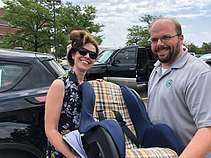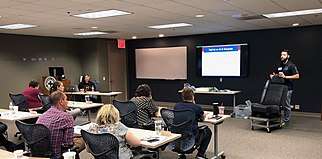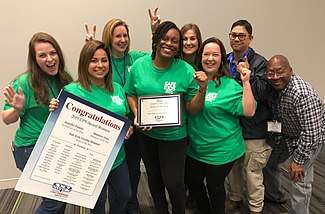National Child Passenger Safety Board
The National Child Passenger Safety Board, managed by the National Safety Council, maintains the quality and integrity of the National Child Passenger Safety Certification Training Program in the United States.[1] The program is used to train and certify child passenger safety technicians and instructors in order to assist caregivers in safe transportation of children. Three of the most common issues that put children at risk: improperly used or installed safety seats, hot cars, and teen drivers.[2] The Board is not limited to keeping kids safe in cars in the U.S. The work of Dr. Marilyn J. Bull to help shape automobile safety law in Chile was highlighted in March 2017 by AAP News.[3]

Background

Traffic crashes are the leading cause of death in children in the United States.[4] In fact, a child under 13 is involved in a crash every 33 seconds.[5] Education and proper use of air bags, car seats, booster seats and seat belts helps save lives and can prevent injuries and deaths on our nation’s roads every day.
Placing children in appropriate car seats and booster seats reduces serious and fatal injuries by more than half.[6] All infants and toddlers should ride in a rear-facing seat until they are at least of 2 years of age.[7] All 50 states require child seats with specific criteria. Requirements vary based on a child's age, weight and height.[8] In a Health Guide published by the New York Times, parents and caregivers can find answers to questions on rear-facing, forward-facing and booster seats.[9] Read the National Safety Council position statement on child restraints, which addresses child passenger safety among multiple modes of transportation.[10]
54% of child heatstroke deaths occur because a caregiver has forgotten a child in a vehicle.[11] In 2017, 42 children died of heatstroke. National Child Passenger Safety Board Secretariat Amy Artuso pointed to distraction as an issue in an article published by CNN.[12] Artuso and San Jose State University's Jan Null are two of the experts consulted in an article published by The Clarion-Ledger.[13] Earlier, Gene Weingarten reported on kids and hot cars in The Washington Post.[14]
Infants and children driven by teen drivers are three times more likely to be injured in a crash than those driven by an adult.[15]
In the United States, Child Passenger Safety Week and National Car Seat Check Saturday are observed every year in September. The purpose of these efforts is to create awareness of car seat safety. Car crashes are the leading cause of death for children 1 to 13 years old. Providing information and car seat safety instructions to parents and caregivers is one way to save lives.[16]
Safe Ride News published a 44-year timeline of child passenger safety advancements, spanning a protest by physicians for automotive safety in 1965 to revisions in school bus seating standards in 2008.[17]
Certification program
Members of the NCPSB work with the National Highway Traffic Safety Administration (NHTSA) and Safe Kids Worldwide. NHTSA has the responsibility to assure the technical accuracy of the curriculum, while Safe Kids CPS Certification is charged with responsibility, authority and liability for the certification and re-certification processes. Board members provide input and perspective from their organizations and to their constituencies on ways to ensure the ongoing significance of the National Child Passenger Safety Certification Training Program in keeping children safe.
History
In the mid-1990s, a small team of child passenger safety professionals was tasked by NHTSA to look at the national state of child passenger safety. The group, the Patterns for Life Team, recommended a standardized national curriculum and a national certification process for technicians. A standardized curriculum was created and AAA became the initial national certifying body. This still left a need for input from those out in the field, and a group of CPS stakeholders, including representatives from national and local organizations, vehicle and car seat manufacturers and injury prevention professionals, was pulled together. The group was formalized and the National Child Passenger Safety Board was created in 1993. The first standardized curriculum was published in 1998. The Board currently oversees the certification curriculum and makes recommendations to both NHTSA and the certifying body, now Safe Kids Worldwide.
Awards

Each year, the Board recognizes men and women for their contributions to child passenger safety through its Technician, Instructor and Team of the Year awards program.
2019 Award Winners
- Omaha's Jennifer Penick became the first person to posthumously receive the Technician of the Year award. Penick, who helped launch Car Seat for the Littles in 2010, was committed to securing children safely in their seats – most notably her own 5-year-old daughter, who survived the same car crash that killed Penick and her husband, Adam, in June 2018. Their daughter, Unity, survived the head-on collision on Highway 50 near Schramm Road because she was properly harnessed in her car seat.
- Mauricio Joya of Indianapolis, IN, was named Instructor of the Year. He was featured in InScope, a weekly newsletter for faculty, staff and students from Indiana University School of Medicine.[18]
- Safe Kids Greater Houston was the first recipient of the Team of the Year award.
2018 Award Winners
- Carina Ortiz, Bakersfield, CA, Instructor of the Year. She was featured on TurnTo23 ABC-TV in Bakersfield.[19]
- Michael "Chris" Morris, Knightsdale, NC, Technician of the Year. He was featured as the man who has "helped babies for decades" by WRAL.com.[20]
2017 Award Winners
- Allan Buchanan, Henderson, NC, Instructor of the Year. He is considered one of North Carolina's pioneers of child passenger safety.[21]
- Brandi Ballinger, Longview, WA, Technician of the Year. She was dubbed the Queen of Car Seat Safety by The Daily News.[22]
2016 Award Winners
- Mark Van Horn, Chadron, NE, Instructor of the Year.
- Patricia Corwin, Columbus, OH, Technician of the Year.
2015 Award Winners
- Suzanne Cash LeDoyen, Raleigh, NC, Instructor of the Year.
- Shawn Vovericz, West Chester, PA, Technician of the Year.
2014 Award Winners
- Jennifer Hoekstra, Grand Rapids, MI, Instructor of the Year.
- Sgt. Brian Cooper, Carol Stream, IL, Technician of the Year.
2013 Award Winners
- Bev Kellner, College Station, TX, Instructor of the Year.
- Amelia “Millie” Jensen, Dilkon, AZ, Technician of the Year.
2012 Award Winners
- Katrina Altenhofen, Washington County, IA, Instructor of the Year.
- Mandi Seethaler, Anchorage, AK, Technician of the Year.
2011 Award Winners
- Beth Washington, Tulsa, OK, Instructor of the Year.
- Giuseppina (Pina) Violano, New Haven, CT, Technician of the Year.
References
- "National Child Passenger Safety Board". National Child Passenger Safety Board. Retrieved 2017-05-17.
- "Child Passenger Safety". National Safety Council. Retrieved 2017-05-17.
- "AAP News". American Academy of Pediatrics. Retrieved 2017-05-17.
- "Injury Facts". National Safety Council. Retrieved 2017-05-17.
- "NSC Child Passenger Restraint Policy". National Safety Council. Retrieved 2017-05-17.
- "Child Passenger Safety". U.S. Centers for Disease Control and Prevention. Retrieved 2017-05-17.
- "Car Seats: Information for Families". American Academy of Pediatrics. Retrieved 2017-05-17.
- "Child Passenger Safety". Governors Highway Safety Association. Retrieved 2017-05-17.
- "Child Safety Seats Health Information". The New York Times. Retrieved 2017-05-17.
- "Child Passenger Restraints Position/Policy Statement" (PDF). National Safety Council. July 2016. Retrieved 2017-05-16.
- "No Heat Stroke". San Jose State University Department of Meteorology and Climate Science. Retrieved 2017-05-17.
- Visser, Steve (2016-06-09). "Deaths in hot cars nearly triple". CNN. Retrieved 2017-05-17.
- Fowler, Sarah (2016-05-20). "How can hot-car deaths be prevented?". The Clarion Ledger. Retrieved 2017-05-17.
- Weingarten, Gene (2009-03-08). "Fatal Distraction: Forgetting a Child in the Backseat of a Car Is a Horrifying Mistake. Is It a Crime?". The Washington Post. ISSN 0190-8286. Retrieved 2017-05-17.
- Chen, I. G.; Elliott, M. R.; Durbin, D. R.; Winston, F. K. (2005-02-01). "Teen drivers and the risk of injury to child passengers in motor vehicle crashes". Injury Prevention. 11 (1): 12–17. doi:10.1136/ip.2004.007617. PMC 1730170. PMID 15691982.
- "Child Passenger Safety Week". U.S. Department of Transportation. 2016-06-17. Retrieved 2017-05-17.
- Stewart, Deborah D. (February 2009). "More than Forty Years of Progress for Child Passenger Protection: A Chronicle of Child Passenger Safety Advances in the USA, 1965-2009". Safe Ride News. Retrieved 2017-05-17.
- "INScope-2019-04-11:: Issues: InScope: Indiana University". inscope.medicine.iu.edu. Retrieved 2019-05-21.
- Johansen, Brandon (2018-05-07). "BPD supervisor awarded 2018 Child Passenger Safety Instructor of the Year". 23ABC News. Retrieved 2018-05-15.
- WRAL. "He's helped babies for decades: Raleigh child passenger safety technician wins national award :: WRAL.com". WRAL.com. Retrieved 2018-05-15.
- "The National Child Passenger Safety Board Names North Carolina Injury Prevention Specialist Child Passenger Safety Instructor of the Year" (PDF). cpsboard.org.
- "Car Seat Technician from Cowlitz 2 Wins National Safety Award". The Daily News. Retrieved 2017-05-17.